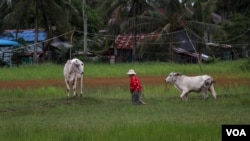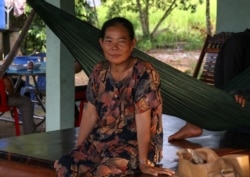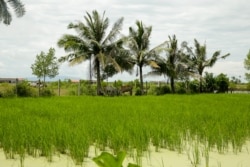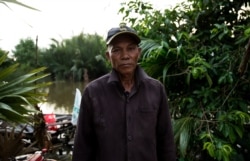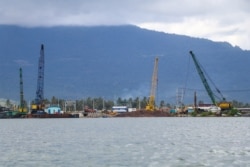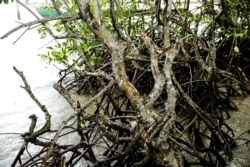CHAMPOU KHMAO VILLAGE, PREAH SIHANOUK PROVINCE — Time passes but the rice cycle stays the same for Nget Srey and other farmers in this remote village in coastal Preah Sihanouk province.
Or at least it did until two years ago, when the saltwater started spilling over the dam blocking nearby sea tributaries, flooding their rice fields.
Last year, Nget Srey’s paddy was almost ready to harvest when her two-and-a-half-hectare field become inundated with seawater, decimating her crops, slashing her main source of income and, she now worries, destroying her way of life.
“My paddy was really good by then and saltwater spilled over and it died out. So did other neighbors’ rice paddies,” said the 58-year-old farmer in Prey Nob district’s Champou Khmao village.
“Now I am really concerned that I can’t do farming anymore,” she added. “Last year there were three floods. It has never happened like that.”
Nget Srey and her neighbors, like coastal farmers around the world, are feeling the effects of saltwater intrusion, a phenomenon in which seawater infiltrates freshwater sources such as groundwater, rivers and aquifer. And it’s being accelerated by a combination of unchecked development and climate change.
While reports forecasting the effects of climate change in Cambodia have predicted that saltwater intrusion will threaten coastal agriculture, the government’s point person on global warming said he wasn’t sure how much of a problem it was for farmers along the 450-kilometer coastline stretching from Kep to Koh Kong.
“There is no data showing saltwater intrusion,” said Hak Mao, director of the Department of Climate Change of the Environment Ministry, “but there might be some areas affected and we need to study more.”
During a trip to coastal communities earlier this month, a half dozen farmers confirmed that it was affecting them. And as farmland turns more saline, some farmers are giving up rice cultivation altogether, leaving them without a reliable food source or a financial lifeline.
Sitting in front of her house in Tuol Tortoeung commune, Nget Srey, the mother of six, said she could only cultivate 20% of her normal paddy rice yield last season, which was hardly enough to feed her own family for the year.
“If the rice is good, I can produce around 10 tons per year. But last year, I could harvest only two tons,” she told VOA Khmer in a recent interview, adding that most years, she is also able to sell around 10 million riels, or $2,500, worth of rice.
A farmer of 20 years, she also rented a piece of farmland last year, with a promise to pay the land owner a ton of rice come harvest time. The seawater wiped out those plans, and the owner sold the land to another person who is now using it to raise shrimp, which need the saltwater.
Nget Srey still has her own two and a half hectares, and she is still growing rice on it. But she is feeling vulnerable. “I am still worried about saltwater spilling again since the dam dike is still low,” she said. “If seawater spills from the dam for one or two days, it will flood the rice field.”
Just a stone’s throw away from Nget Srey’s house is Sorn Touch, another rice farmer who said saltwater flooded his three hectares of paddy field late last year, costing him around $1,000.
“I have lived here for more than 30 years, and there was never such big water,” the 60-year-old told VOA Khmer. “Last year, there was a lot of water.”
Normally, he said, the water rises from October to December, but it was becoming less predictable — and more difficult for the dikes to hold it back.
“Saltwater easily gets into our land via the dams,” he said, adding that the dams should be higher to prevent seawater from entering fields at the end of the year. “The dams are low,” he said, while “the seawater rises higher.”
The conditions make farming precarious, but Touch sees little choice. “It is difficult to do farming here, but we have rice fields here, so we have to do farming every year,” he said.
Like Nget Srey, Touch and his wife, Sem Rem, 54, also rented land nearby to grow rice to eat and sell. But she completely lost her harvest last year, putting her out about $1,500.
“Last year, I couldn’t harvest even a seed. The land is not good since it is still saline. It was complete destruction,” said Sem Rem, a mother of five. “This year, I’m not farming on the rented land since I am afraid of losing it again.”
While saltwater intrusion can be caused by a number of human-caused factors — from climate change to deforestation and river dredging — rising sea levels are a major contributor.
In Cambodia, the sea level could increase by more than half a meter by 2090 under the worst climate scenarios, which would inundate some 25,000 hectares, significantly increase vulnerability to storms and negatively affect coastal tourism, according to Cambodia’s Climate Change Strategic Plan, a government document published in 2013.
In Kampot province’s Treuy Koh commune, 40-year-old farmer Deu Bern said saltwater destroyed patches of rice fields last year — including half a hectare of her own paddy.
“Now people here have stopped growing rice. There is only me doing it. “Some have sold their land already,” said the mother of two daughters, aged 17 and 14.
“When saltwater pours in the rice field, the soil becomes red, dies out and becomes saline,” she said, adding that villagers can’t grow rice unless they pump freshwater into the field to clean the soil.
In the coming decades, coastal areas and the central plains, according to the 2013 report, are expected to become increasingly vulnerable to flooding, affecting agriculture, fisheries, tourism, shipping and other industries.
Hak Mao of the Environment Ministry said sea levels could rise by as much as one or two meters by 2100, based on some scenarios, which would only compound the devastation.
He said Cambodia’s government has “done well” to lessen the impacts of climate change, explaining that things could be much worse. But he recognized that Cambodia is highly vulnerable to climate change, due to factors including its reliance on agriculture, financial limitations and poor infrastructure.
“We observe that Preah Sihanoukville province is the most seriously impacted by climate change. But in the long run, if sea water level rises as forecast, Koh Kong province will be more vulnerable to floods,” he said.
But Hang Sophea, a 38-year-old farmer in Koh Kong province’s Mondol Seima district, felt like more could be done to address the saltwater intrusion, noting that dam dikes in the area were small and often broken.
“I don’t know whom I should ask to help. But I want authorities to fix the dykes and build them higher,” she said.
The mother of two, who is now eight months pregnant, is taking a break from farming her three hectares of low-lying land, since she’s about to deliver a child and her husband is busy with farming other crops.
But she worries that in future years, it will be the seawater that prevents her family from having an annual rice crop. “I am still worried about saltwater flooding into the rice field, she said, “but I have to do rice farming since I have the land and I need rice for food and to feed the chickens.”
Without rice to feed the chickens and ducks she raises, “we can’t have savings. We just live from hand to mouth,” she added.
Sophea’s neighbor, Ho Sophal, 58, a rice farmer and primary school teacher, blamed the floods in part on the nearby forests being destroyed. “Seawater is rising every year in the area around the sea tributary,” he said, adding that the dikes are not high enough to hold it back, “which I am worried about.”
Sophal believes in scientists’ warnings that the rise of the sea will eventually inundate the lower areas along the coastline, which he blames on global warming caused by human emissions and deforestation. And he is worried the rice fields won’t be the only thing destroyed in his coastal community.
“It is always risky to live nearby saltwater,” he said. “I am concerned that a big rise in the seawater could wash villagers’ houses away in the future.”




